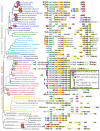Evolution of bacterial trp operons and their regulation
- PMID: 18374625
- PMCID: PMC2387123
- DOI: 10.1016/j.mib.2008.02.005
Evolution of bacterial trp operons and their regulation
Abstract
Survival and replication of most bacteria require the ability to synthesize the amino acid L-tryptophan whenever it is not available from the environment. In this article we describe the genes, operons, proteins, and reactions involved in tryptophan biosynthesis in bacteria, and the mechanisms they use in regulating tryptophan formation. We show that although the reactions of tryptophan biosynthesis are essentially identical, gene organization varies among species--from whole-pathway operons to completely dispersed genes. We also show that the regulatory mechanisms used for these genes vary greatly. We address the question--what are some potential advantages of the gene organization and regulation variation associated with this conserved, important pathway?
Figures


References
-
- Gutierrez-Preciado A, Jensen RA, Yanofsky C, Merino E. New insights into regulation of the tryptophan biosynthetic operon in Gram-positive bacteria. Trends Genet. 2005;21:432–436. - PubMed
-
The extensive studies of Trp-pathway regulation in Gram-positive bacteria within the Bacillales Order provide an excellent comparative complement to what is known of Gram-negative bacteria related to Escherichia coli.
-
- Yanofsky C. Using studies on tryptophan metabolism to answer basic biological questions. J Biol Chem. 2003;278:10859–10878. - PubMed
Publication types
MeSH terms
Substances
Grants and funding
LinkOut - more resources
Full Text Sources
Other Literature Sources

